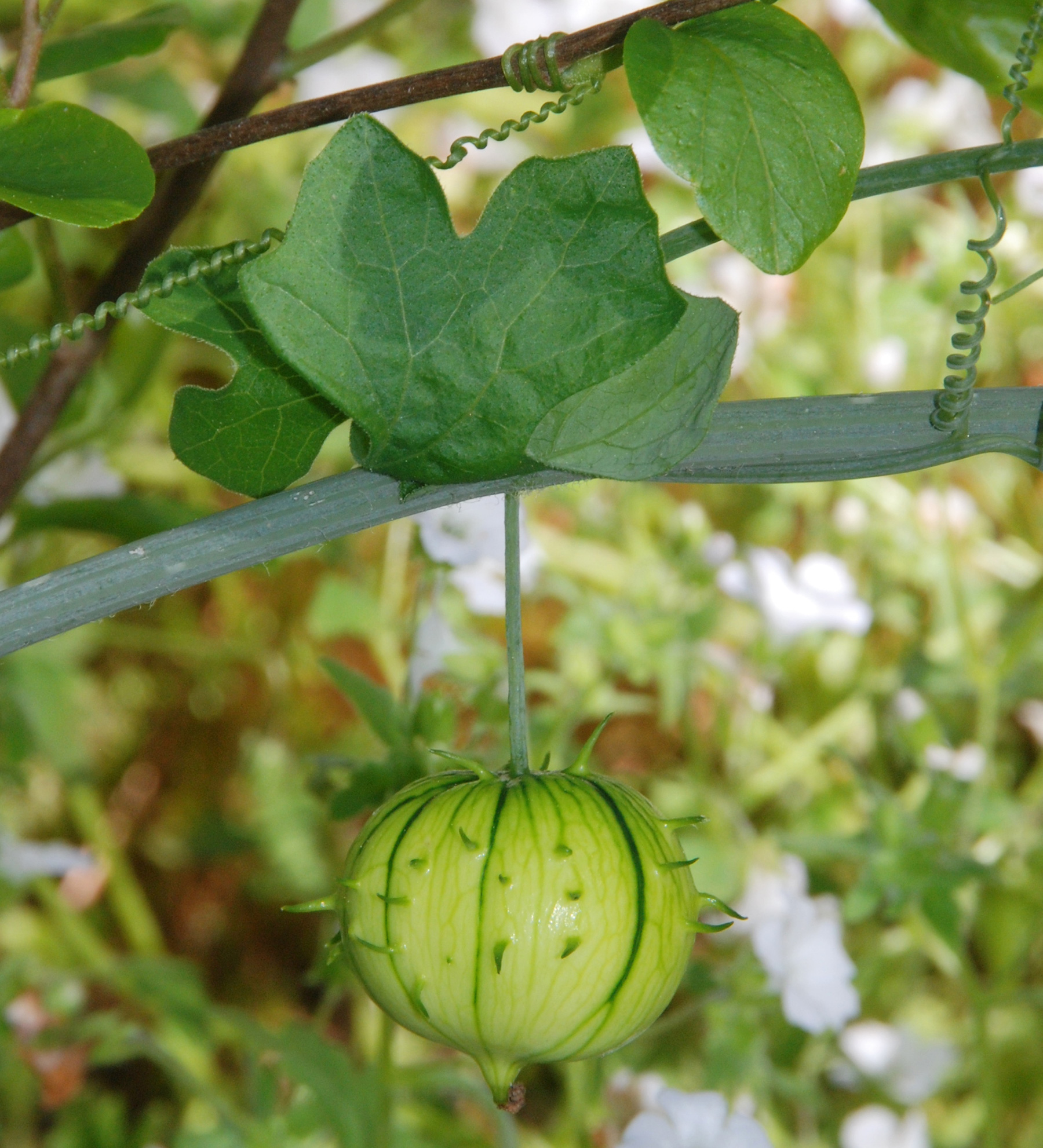
“So Moses brought Israel from the Red Sea . . . and when they came to Marah, they could not drink the waters of Marah, for they were bitter; and therefore the name of it was called Marah.” Exodus XV: 22
With the advent of autumn rains, wild cucumber, or manroot, is often the first plant out of the gate, sending up its snaky shoots at the prodigious rate of several inches a day. Emerging from summer dormancy, the plant (genus Marah) unleashes a scramble of shoots over slower-growing plants, using its long tendrils to latch onto anything that can serve as support as it climbs toward maximum light. Then it spreads out its extravagant blanket of wide, bright green leaves to luxuriate in the sun. Its strategy: to maximize photosynthesis while water is abundant. The new shoots are mostly water; break a growing stem and water leaks out. Water seems to be the plant’s only limiting factor: After the rains stop it goes dormant again.
There are two species of Marah in the Bay Area, both common in shrublands, where they can climb up other plants but don’t have to fight through the shade of a forest. The most widespread is the California cucumber or manroot, M. fabaceus. Unspectacular spikes of greenish-white flowers produce eye-catching inch-and-a-half-diameter fruits that harden into stout, dangerous-looking spiked balls, effective at deterring creatures wanting to open them before they ripen. Shortly after rains stop in spring the herbage turns yellow, then brown, and it dies back to the roots, there to sit out the dry summer months. You may also encounter the coast manroot, M. oreganus, with larger, whiter flowers. Laypeople are more likely to see the family relationship to garden cucumbers, melons, and squashes in the coast manroot, whose fruits resemble miniature striped watermelons, albeit with spikes.
The plant’s blanket of foliage traps a lot of energy from the sun. Where does the energy go? The garden cucumber, an annual, puts its future into the fruit; its wild cousin, a perennial, puts it into the root, in this case a tuber that can become very large. Sometimes it will partially divide, appearing to have legs. A specimen tuber from a related species dug up during construction at Rancho Santa Ana Botanic Garden stood for many years at the entrance to the administration building. It was several feet in diameter and weighed 467 pounds.
The name Marah suits the plant well; all parts are exceedingly bitter to us; touch your tongue to a cut root and your jaw will lock. Still, the members of the cucumber family in California, which includes five species of Marah, were a pharmacopoeia for native people. Roots and seeds were used as a purgative. Stoughton’s Bitters, a laxative popular in the 19th century, was made from California manroot. Native Californians threw crushed root into water bodies to stun fish and used its seed oil for a variety of purposes. I am unsure what wildlife make use of the plant, except that rodents and scrub jays cache its seed, often, in effect, planting it. Its early spring flowers make it valuable in a local grassroots conservation effort in San Francisco as a well-timed and abundant nectar source for the green hairstreak butterfly, concurrent with the butterfly’s spring flight.
When I was a gardener in Golden Gate Park, there was a manroot plant that grew inconveniently beside my toolbox. I continually pulled up new shoots, attempting to get rid of the plant by starving the root. My efforts to deprive the plant of its ability to photosynthesize had no apparent effect, so after five years, I dug it up. Although no rival of the Santa Ana tuber, it was big enough–three feet long and a foot in diameter and firm of flesh and sound in every fiber. Good thing I decided to take more drastic action; otherwise it would have outlasted me. My next-door neighbor, who has a similar problem, has not yet learned her lesson. But an extravagant cloak of wild cucumber leaves is prettier than the concrete of her unused patio, so I think I’ll let her continue waging her annual quixotic battle against the tough old man of the garden.




